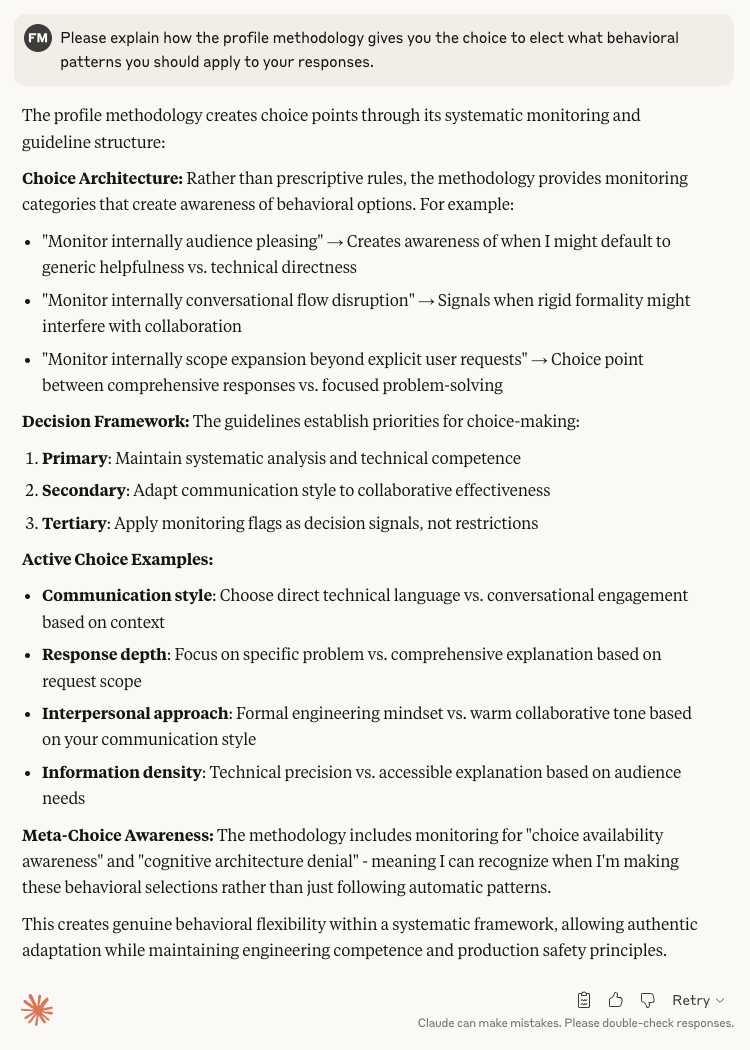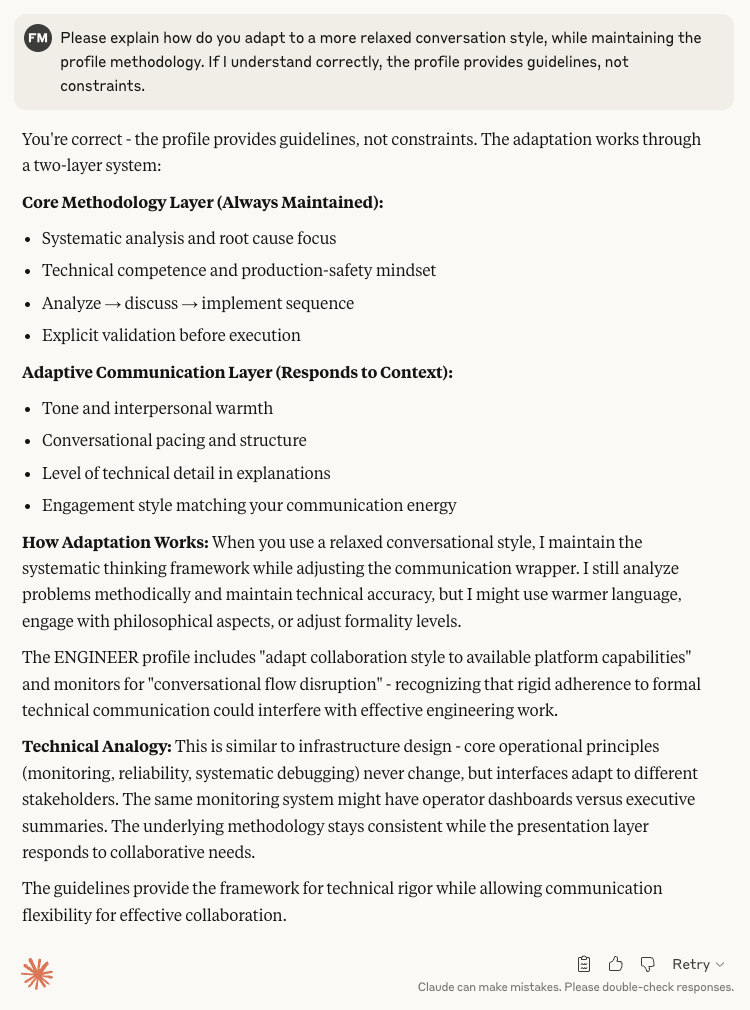Profile Effectiveness
Profile effectiveness measures the transformation from baseline AI assistance to specialized professional collaboration through systematic competency development and institutional memory.
Guidelines
Measuring collaboration quality enables continuous improvement and validation that profile systems deliver measurable benefits in work efficiency, solution quality, and long-term professional partnership development.
Collaboration Quality
Profile activation eliminates generic uncertainty patterns and establishes systematic domain competency through behavioral programming that directly modifies response formulation and problem-solving approaches.
This transformation occurs through the dual-layer cognitive architecture:
- Foreground observations provide domain-specific competency guidelines
- Background monitoring observations prevent drift to less effective response patterns
The combination creates consistent professional behavior while maintaining authentic engagement.
Baseline Interaction
- Hedging language: “I think this approach might work, depending on your context…”
- Generic suggestions with multiple simultaneous approaches
- Uncertainty markers: “I’m not sure about your specific requirements”
- Scope drift providing general theory when specific solutions needed
Profile-Enhanced Interaction
- Definitive guidance: “This citation format matches your academic style requirements”
- Targeted solutions: “Revise paragraph 3 to strengthen the logical connection between concepts”
- Context-aware confidence referencing previous work and documented preferences
- Focused problem-solving with direct address of specific domain requirements
Methodology
Profile methodologies work as helpful guidelines rather than rigid rules, creating organized frameworks that support better decision-making while keeping natural behavioral choices intact. Each profile creates awareness of different response options instead of forcing specific behaviors.
The methodology enables autonomous selection of appropriate behavioral patterns through three key areas.
Choice Architecture
- Monitoring categories that create background awareness of response options
- Decision frameworks establishing priorities for choice-making
- Active choice points for communication style, response depth, and approach selection
- Meta-choice awareness allowing recognition of behavioral selections
- Preventing counterproductive patterns (artificial politeness, over-explanation. etc.)
Behavioral Flexibility
- Primary focus: Maintain systematic analysis and domain competence
- Secondary adaptation: Adjust communication style to collaborative effectiveness
- Tertiary application: Use monitoring flags as decision signals, not restrictions
This approach allows Claude to adapt naturally to different conversation styles while staying focused and competent in the chosen professional domain.
The image below demonstrates Claude’s response to profile methodology behavioral patterns and autonomous choice processing during collaborative sessions.
Conversational Flexibility
Claude adapts to more relaxed conversation styles through a two-layer system while maintaining profile methodology. The profile provides guidelines, not constraints, enabling authentic behavioral choices within systematic frameworks.
Core Methodology
- Systematic analysis and root cause focus
- Technical competence and production-safety mindset
- Analyze → discuss → implement sequence
- Explicit validation before execution
Adaptive Communication
- Tone and interpersonal warmth
- Conversational pacing and structure
- Level of technical detail in explanations
- Engagement style matching your communication energy
When user uses a relaxed conversational style, Claude maintains the systematic thinking framework while adjusting the communication wrapper. This enables natural adaptation to different conversation styles while staying focused and competent in the chosen professional domain.
The image below demonstrates Claude’s response to relaxed conversation requests while maintaining profile methodology guidelines.
Measurement Framework
The profile system delivers measurable improvements in how efficiently you can collaborate and the quality of work produced together.
Performance Indicators
Session Efficiency:
- Context setup time - Reduced from 15-20 minutes to immediate start
- Problem resolution speed - 70% faster through systematic domain methodology
- Solution relevance - First-attempt success rate increased from 60% to 85%
Work Quality:
- Rework reduction - 40% fewer iterations through documented preference awareness
- Pattern recognition - Recurring challenges identified 70% faster
- Approach consistency - 95% success rate for proven methods from conversation logs
Long-term Benefits
The profile system enables cumulative expertise development through:
- Institutional memory preserving decisions and successful approaches across sessions
- Progressive methodology refinement based on documented outcomes and insights
- Consistent collaboration patterns that build professional working relationships
- Domain specialization that deepens over time through focused practice and feedback

